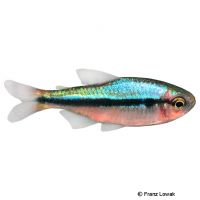Black Stripe Tetra (Hyphessobrycon melanostichos)
| Black Stripe Tetra Hyphessobrycon melanostichos | |
|---|---|
| Name | Black Stripe Tetra |
| Name Lat. | Hyphessobrycon melanostichos |
| Family | Characins |
| Family lat. | Characidae |
| Order | Characins |
| Order lat. | Characiformes |
| Origin | South America |
| Habitat | Streams, rivers |
| Diet | Carnivore |
| pH | 5.5-7.5 |
| Behavior | Peaceful |
| Keeping | Group |
| Care Level | Moderate |
| Reproduction | Egg scatterer |
| Breeding | Difficult |
| Life Span | 3-5 years |
| Protection | No |
| Metric Units | |
| Size | 3,5 cm |
| Temperature | 22-28 °C |
| Hardness | 1-10 °dH |
| Aquarium | ~ 100 l |
| US Units | |
| Size | 1.5" |
| Temperature | 72-82 °F |
| Hardness | 18-178 ppm |
| Aquarium | ~ 25 gal |
Distribution and habitat
The distribution area of the Blue Blackbanded Tetra is the Rio Doze de Outubro in the upper inlet of the Rio Tapajos in Brazil. They live in the clear waters of shallow, slow-moving streams and rivers, with rounded stones on sandy bottoms partially covered with branches and fallen leaves.
Maintenance
The aquarium should have a varied, partly dense planting, with shelters and hiding places (roots) and provide sufficient swimming space. Soft, slightly acidic water, a dark substrate covered with some foliage (e.g. sea almond leaves), shaded light (floating plants) and a weak current is ideal.
No ammonia, ammonium and nitrite should be detectable, the nitrate value should not exceed 100 mg/l. To ensure the water quality and oxygen content, a filter and heater adapted to the aquarium size is required, as well as lighting for the species-appropriate day-night rhythm of the animals.
Diet
In nature they feed mainly on small insects and larvae. The food supply consists of live, frozen and dry food. For a balanced diet, feed once a day with a high-quality, protein-rich dry food (flakes, granules, micro-pellets) and with cyclops, daphnia or mosquito larvae (live or frozen).
It is recommended to feed small portions several times a day, which are eaten within a few minutes. A regular and varied diet promotes health and increases resistance.
Behaviour and compatibility
They are lively fish and should only be socialized with other lively fish. Care should be taken with long finned fish. At least 5, but preferably many more Blue Blackbanded Tetras should be kept together. In groups that are too small or aquariums that are too small, intraspecific aggression will quickly occur
In principle, only mutually compatible fish species with similar demands on water quality and water temperature should be kept together.
Sex dimorphism
The sexes are hardly distinguishable. During courtship, the males are more intensely colored. The females are somewhat stockier and appear more rounded
Reproduction and breeding
In soft, slightly acidic peat water they usually spawn between fine-feathered plants (free spawners). The larvae hatch after approx. 24 hours and swim freely from the 5th day.
Juveniles must be fed several times a day with special rearing food (dust food). In community tanks breeding is hardly possible, because the spawn is easy prey.
Important
Kept in a group, other fish are rarely bothered and their occasionally quarrelsome behavior remains intraspecific.
The well-being of the fish should be monitored regularly. Temperature should be checked daily, pH, hardness and nitrate levels at least fortnightly. Regular partial water changes are recommended, even if the pollutant load has not yet reached the upper limit. Sudden changes in water quality should be avoided. Newly introduced fish must be accustomed slowly to the water in the aquarium.
Further literature can be found in your pet store.
References
Text: petdata; Image: Franz Lowak
Source: BMELV (1998): Tierschutzgutachten - Haltung von Zierfischen (Süßwasser); BAENSCH & EVERS (2004): Aquarien Atlas Bd. 6, Mergus Verlag; ENGELMANN (2005): Zootierhaltung - Tiere in menschlicher Obhut: Fische, Verlag Harri Deutsch
- Gemäß § 21 Abs. 5 Tierschutzgesetz idgF
